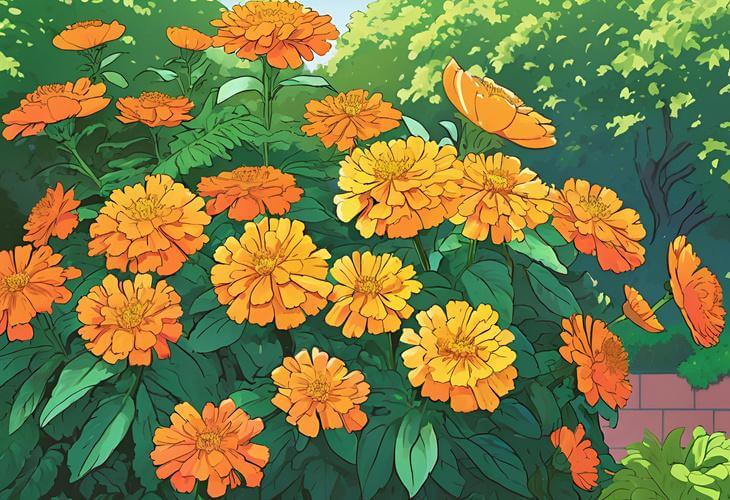
Marigolds (Tagetes spp.) are among the most widely grown and easily recognized flowers in American gardens. With their sunny blooms in shades of yellow, orange, gold, and maroon, marigolds bring cheerful color, effortless beauty, and a host of benefits to gardeners and pollinators alike.
Native to the Americas, marigolds are warm-season annuals known for their quick growth, pest-deterring properties, and abundant blossoms. They’re especially popular in companion planting schemes and pollinator gardens for their versatility, low maintenance, and long blooming period—from early Summer to frost.
Whether you’re growing them to brighten a garden bed, protect vegetables, or draw in bees and butterflies, marigolds are a reliable favorite.
Soil (pH) Requirements
Marigolds are highly adaptable, but they prefer well-drained, moderately fertile soil with a neutral to slightly acidic pH—typically between 6.0 and 7.0.
Tips for Best Results
- Ensure soil isn’t overly rich, which can produce more foliage than flowers.
- Improve drainage with compost or aged manure in heavy soils.
- Avoid waterlogged conditions—marigolds dislike soggy feet.
Sun Requirements
Marigolds thrive in full sun, needing at least six hours of direct sunlight daily to bloom their best. In shady spots, they may become leggy and produce fewer flowers.
Ideal Locations
- Borders and raised beds
- Containers on sunny patios
- Around vegetable gardens as pollinator lures and pest deterrents
Watering Requirements
Marigolds are fairly drought-tolerant once established, but they appreciate consistent watering, especially in hot or windy weather.
Watering Tips
- Keep soil evenly moist but not soggy during early growth.
- Reduce watering once plants mature and develop deeper roots.
- Water at the base of the plant to prevent fungal diseases on foliage.
Best Plant Hardiness Zones
Marigolds are annuals across the United States and are best suited to USDA Hardiness Zones 2-11. They grow quickly from seed or transplant and bloom continuously until the first frost.
Seasonal Notes: In Zones 9–11, they can be grown nearly year-round.
In colder zones, start seeds indoors four to six weeks before the last frost or direct-sow after danger of frost passes.
Marigold Popularity and Pollinator Appeal
Gardeners love marigolds for far more than just their good looks. Their ability to repel certain pests (like nematodes and aphids) makes them a natural companion plant. But they also play a vital role in pollinator support—particularly for smaller, often-overlooked garden allies.
While not as rich in nectar as some wildflowers, marigolds provide ample pollen and attract:
- Hoverflies (which control aphids)
- Native bees (especially small sweat bees and leafcutter bees)
- Honeybees (drawn to single-flowered forms)
- Butterflies, especially skippers and small brush-footed varieties
Their long blooming season means pollinators have a steady food source throughout Summer and into Fall—especially important during seasonal lulls.
Five Popular Marigold Varieties and How to Use Them
African Marigold
Also known as American marigolds, these are the tallest and showiest marigold type, producing large, round blooms in shades of gold, orange, and yellow. Plants can grow up to 3 feet tall, making them ideal for back borders or dramatic centerpieces.
Popular Uses
- Mass planting for high-impact color
- Cut flowers and ceremonial garlands
- Companion planting in large vegetable plots
Pollinator Note: Taller varieties with open-petaled centers attract native bees and offer excellent visibility to hoverflies.
Best Zones: 2–11
French Marigold
French marigolds are compact and bushy, reaching 6-12 inches tall. Their flowers range from single to double blooms in vibrant mixes of red, orange, and yellow. They’re often the top choice for edging paths or planting in containers.
Popular Uses
- Low borders and pathway edges
- Interplanting with herbs and vegetables
- Colorful container gardening
Pollinator Note: This variety attracts hoverflies and small solitary bees, which appreciate the easy-to-access pollen.
Best Zones: 2–11
Signet Marigold
Signet marigolds are delicate, mounding plants with fern-like foliage and tiny, single-petaled flowers. Their blooms have a light citrus scent, and the petals are edible, adding flair to salads and desserts.
Popular Uses
- Edible landscaping
- Pollinator-friendly herb gardens
- Summer salads and garnish trays
Pollinator Note: These open-faced flowers are favorites of tiny native bees, hoverflies, and skippers. They bloom profusely all Summer long.
Best Zones: 3–11
Strawberry Blonde Marigold
A newer variety, Strawberry Blonde offers unique multicolored petals in pastel shades of pink, apricot, and cream. Its bushy, compact habit is ideal for containers or front-of-border plantings.
Popular Uses
- Decorative patio planters
- Color-coordinated flower beds
- Unique color accents in pollinator gardens
Pollinator Note: Despite its appearance, this variety retains open blooms that small bees and hoverflies will visit frequently.
Best Zones: 3–10
Crackerjack Mix Marigold
This heirloom African marigold includes tall, full-petaled blooms in classic gold, yellow, and orange. It’s vigorous, heat-tolerant, and a top pick for bold, rustic garden designs.
Popular Uses
- Cottage garden backdrops
- Tall border accents
- Floral arrangements and DIY dried flowers
Pollinator Note: The dense, high-visibility blooms attract butterflies looking for high landing pads, and bees appreciate the plentiful pollen.
Best Zones: 2–11


 Previous
Previous

